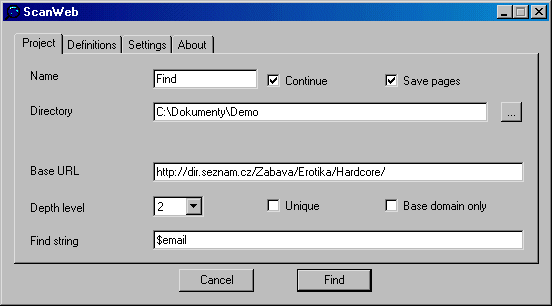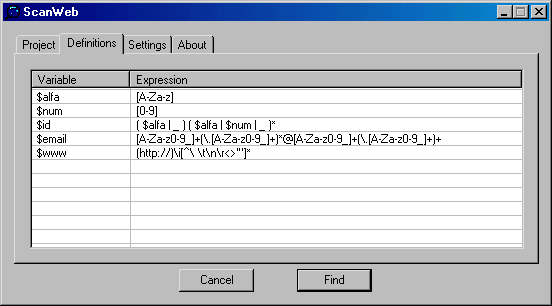 |
| Sinossi |
|---|
| ScanWeb |
|
ScanWeb is program for on-line finding of regular expressions on WWW pages. Pages must be in depth to N of links from entered base URL. The N you can to set. You can select term of validity for pages. Program be able to save of pages with sought expression. Finding is persistent: possibility of regeneration after shutdown the program or computer. You can have more finding operations concurrently. Output is page in HTML format with list of found expressions. Program can be localize to other languages as Windows Commander. |
|
Definition of finding plan |
|
|
|
Regular expressions table |
Program package include predefined set of regular expressions. Definition set is on Figure 2. You can add new definitions to the set. All rows you write as $variable = expression. Table control:
You can define of regular expression with using some previous definition. order is important. |
|
|
Additional conditions |
You can set obligatory content, forbidden content and maximum size of page. Page out of the conditions is not for finding. Obligatory or forbidden content is in regular expressions form. |
|
|
Set of language |
Select of language on third tabpage. You can create new labels for other laguage. Validity and right location is necessary for functionality. Create new labels that way:
|
|
|
Regular expressions |
Concatenation of regular expressions is some text. E. g. '(Hallo (,\ how\ are\ you\?)?)' can to be 'Hallo', or 'Hallo, how are you?' |
|
| Figure 1 |
|---|

| Figure 2 |
|---|

| 0.2 MB | ScanWeb 1.2 32 bit (9.5.2002) | |||
|
ScanWeb is freeware. All files are in ZIP archive. No installation. Extract and you can use it. |
||||
| Language Versions |
|---|
|
There is no specific language better supported by the EServer than the others. Each language version has its own directory, named by a two-character abbreviation same as that used at the www header. For example, for Czech it is cz, for Slovak sk, for English en, etc. The advantage of this system is, that it enables to make specific menu, index page and advertisements for each language. Should you wish to create a new language version for visitors of your web pages, proceed simply as follows:
Copying the language version, the new one has also inherited advertisements from the parent version. Now you can adapt it to the new language. The above procedure is sufficient to have the new language version suitable for an usual visitor. Should you wish to have it complete, you must also translate manuals for the EServer, which represents greater volume of texts. If you decide to do that, please contact the administrator. |